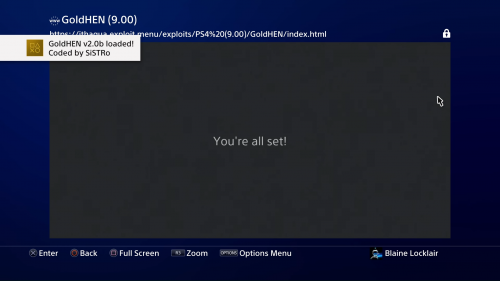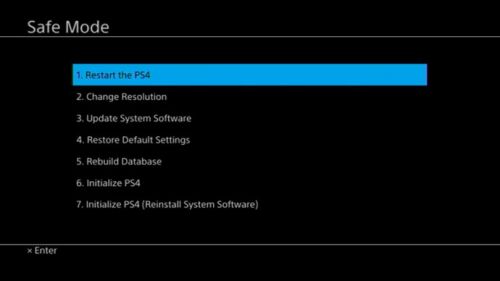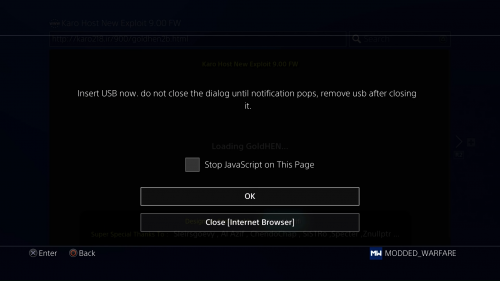Standard Jailbreak
Jump to navigation
Jump to search
This page will walk you updating your console to an appropriate firmware (if needed) and enabling homebrew.
Determining your Firmware
- Jailbreaking can only be achieved on a firmware lower than latest.
- To determine your firmware, navigate to Settings > System > System Information on your PS4.
- Take note of your firmware. If you're on 11.00 or anything lower you can continue.
What firmware is the best?
To keep it short, different firmwares will need different exploits, thus can lead to various levels of stability and success rates. Please do keep in mind that they can be updated in the future.
If you are on:
- <5.05 - either keep it for archiving purposes or update to 5.05 or 9.00.
- 5.05 - it’s considered the gold firmware because of its stability and success rate. Either stay on it or update to 9.00 (note that you will need to backport most of your new games in order to play them)
- 6.72 - stay on it or update to 9.00
- 7.02 & 7.5x (7.50, 7.51 & 7.55) - stay on it or update to 9.00
- 8.0x & 8.50 - update to 9.00
- 9.00 - stay or update to 11.00
- 11.00 - currently the latest exploitable firmware
- Download 9.00 (or your desired) firmware file on your PC by visiting one of the following sites. Do not get beta firmwares.
- DKS - PS4 Official Firmwares - Recommended because of the faster download speeds.
- PS4 Firmwares - Darthsternie's Firmware Archive - No account or CAPTCHA required, but slower download speeds.
- If you want to start fresh and reset the console, you will need to download a recovery update file. These will always be around 1 GB in size.
- If you want to update an existing console, do not use a recovery file an only use a normal firmware update. They will be around 500 MB or less in size.
- Unpack your archive and rename the file to PS4UPDATE.pup (must be in all caps).
- Prepare a USB stick drive by formatting it to FAT32 and creating a folder on the root of the drive named PS4 and another folder inside PS4 named UPDATE. Copy PS4UPDATE.pup in the UPDATE folder. The final structure should look like this:
PS4 > UPDATE > PS4UPDATE.pup. - Boot into PS4's recovery settings by turning off the PS4 and holding the PS4 button until it beeps 2 times. Recovery mode should look like this:
- Plug the USB stick into an empty slot on your PS4.
- Select one of the following options depending on if you want to reset the console or not.
- If you only wish to update the console's firmware and keep the installed hard drive data, select
3. Update System Software> OK > Yes. - If you wish to reset the console and start fresh, select
7. Initialize PS4 (Reinstall System Software)> OK > Yes.
- If you only wish to update the console's firmware and keep the installed hard drive data, select
- The PS4 will now install the firmware on the HDD.
- REMOVE ANY ETHERNET CABLE AND/OR SKIP WI-FI SETUP. Keep everything offline during and after setting up your PS4.
- After setup, navigate to Settings > System > Automatic Downloads > Uncheck Featured Content, System Software Update Files, Allow Restart and Application Update Files.
Enabling Homebrew
Internet Settings (Without PPPwn)
If you are using the PPPwn method, avoid this section as it needs a different configuration detailed in the PPPwn instructions.
Navigate to Settings > Network > Check Connect to the Internet, then Set Up Internet Connection and:
- Connection: Wi-Fi or LAN cable
- Set Up: Custom
- IP Address: Automatic
- DHCP Host Name: Do Not Specify
- DNS Settings: Manual
- Primary DNS: 62.210.38.117 - Explanation: This DNS will redirect you to a jailbreak website.
- MTU Settings: Automatic
- Proxy Server: Do Not Use
- Note: For some people, their Internet Provider will block DNS’s, thus not allowing you to use the 2 DNS Addresses. If you are one of those people, please use the ALTERNATIVE GUIDE.
Firmwares less than 9.00
- Navigate to Settings > User's Guide/Helpful Info > User Guide. The website loaded should be an exploit host instead of the user guide.
- Select Karo.
- Select Goldhen for your firmware version.
- Goldhen505 for 5.05, Goldhen755 for 7.55, etc.
- If it is the first time the page is loaded, it will be cached, and will have to be manually reloaded once prompted.
- Wait for the exploit to trigger. If you see the "GoldHEN loaded" message, you have jailbroken the PS4.
- If you see "Not enough memory", select OK.
- Exit the user-guide by holding the back button.
- For recommendations on what to do next, see Recommended Setup.
Firmware 9.00 (pOObs4)
- Download Rufus and pOOBs4/exfathax.img exfathax.img on your PC. Plug a USB drive to your PC.
- In Rufus > Device (select your USB stick) > Boot Section: Disk or ISO image and select exfathax.img > Start. Note that this will erase the USB drive.
- Back on the PS4, navigate to Settings > User's Guide/Helpful Info > User Guide. The website loaded should be an exploit host instead of the user guide.
- Select Karo.
- Select Goldhen900.
- If it is the first time the page is loaded, it will be cached, and will have to be manually reloaded once prompted.
- Do not move your mouse cursor and have patience. If you see "Not enough memory", select OK and continue until you see this screen:
- If successful, a "Jailbreak Done" prompt should appear, remove the USB drive from the PS4, then press OK.
- If you see the "GoldHEN loaded" message, you have jailbroken the PS4:

- Exit the user-guide by holding the back button.
- For recommendations on what to do next, see Recommended Setup.
Firmwares 9.60, 10.00, 10.01, & 11.00 (PPPwn)
Raw C++ Rewrite method (Windows)
The C++ method is faster on old and new hardware and benefits of an auto retry and integrated interface listing command.
- Download and install Npcap1.79
- Download for x86 PPPwn-C++ or x86_64 PPPwn-C++ and unpack it in a folder
- You will also need stage1 and stage2 files that you can get from this GitHub
- Place the stage1 folder and stage2 folder for your firmware in the same folder as the unpacked pppwn file.
- Then download Goldhen and place the goldhen.bin that is inside the 7z file on a USB Drive formatted in EXFAT or FAT32 then connect it to your PS4
- Connect your PC and PS4 via ethernet so the ethernet adapter becomes active.
- Open a cmd window and cd to the folder where the pppwn file is and type in the following command:
pppwn list
- Find your ethernet adapter name on to the right then to the left here will be line of numbers and letters inside of {} >example \Device\NPF_{9F25F85D-3755-46A6-93B3-9173DFCB1632} copy it.
- Example> \Device\NPF_{9F25F85D-3755-46A6-93B3-9173DFCB1632}
- You can go to the PS4 and apply the following internet settings.
- On your PS4
- Go to Settings and then Network
- Select Set Up Internet connection and choose Use a LAN Cable
- Choose Custom setup and choose PPPoE for IP Address Settings
- Put in g as Username and Password
- Choose Automatic for DNS Settings and MTU Settings
- Choose Do not use for Proxy Server
- Go back and be ready to press on Test internet connection
- Back in the cmd window you can now run the following command by adding your ethernet adapter name to the example below and changing the firmware version to your own:
pppwn --interface \Device\NPF_{9F25F85D-3755-46A6-93B3-9173DFCB1632} --fw 1100 --stage1 "stage1/stage1.bin" --stage2 "stage2/stage2.bin" --timeout 10 --auto-retry
Raw Python method (Windows)
- Download and install Npcap1.79
- Download and install Python and make sure to ADD TO PATH and run as Admin then restart your PC.
- Open a CMD Window and paste the following commands.
- python -m ensurepip --default-pip
- pip install scapy
- Then download pppwn.py and offsets.py. You will also need stage1 and stage2 files that you can get from this GitHub
- Place the stage1 folder and stage2 folder for your firmware in the same folder as pppwn.py, offsets.py.
- Then download Goldhen and place the goldhen.bin that is inside the 7z file on a USB Drive formatted in EXFAT or FAT32 then connect it to your PS4.
- Connect your PC and PS4 via ethernet so the ethernet adapter becomes active.
- Open a Windows PowerShell window and run this command.
- Get-NetAdapter | Select-Object Name, InterfaceDescription, InterfaceGuid
- Your ethernet adapters will be listed find the one with the corresponding name to your ethernet port(you can check in your connection settings or with ipconfig in a cmd window)
- To the far right of its name will be a line of numbers and letters inside of {} >example {9F25F85D-3755-46A6-93B3-9173DFCB1632} copy it along with the {}.
- Add this to it \Device\NPF_
- Example> \Device\NPF_{9F25F85D-3755-46A6-93B3-9173DFCB1632}
- You can go to the PS4 and apply the following internet settings:
- Navigate to Settings > Network > Check Connect to the Internet, then
Set Up Internet Connection - Select
Set Up Internet connectionand chooseUse a LAN Cable - Choose
Custom setupand choosePPPoEfor IP Address Settings - Put in
gas Username and Password - Choose
Automaticfor DNS Settings and MTU Settings - Choose
Do not use for Proxy Server - Go back and be ready to press on
Test internet connection
- Navigate to Settings > Network > Check Connect to the Internet, then
- Go back to a cmd window and cd into the folder from Step 8.
- In the open cmd window you can now run the following command with your ethernet adapter id from step 13-15 and the firmware version > example bellow.
pppwn.py --interface=\Device\NPF_{9F25F85D-3755-46A6-93B3-9173DFCB1632} --fw=1100
- If Scanning for corrupted object fails press CTRL+C then run the command from step 21 again.
Troubleshooting
- An error "Not enough memory" appears.
- It's a common error. Keep pressing OK until you pass it.
- The PS4 just shutdown/rebooted itself.
- Another common error. Do not worry, remove the USB drive if on 9.00 and keep trying the same procedure starting with User Guide.
- I rebooted the PS4, and now I can't launch my games/apps.
- Jailbreaking is not persistent/permanent and as a result you need to re-jailbreak your PS4 every time you reboot/shut down your PS4. As a alternative, you can put your PS4 on rest mode and you don't need to re-jailbreak.
- Will my PS4 die from doing this?
- No, even forced reboots won't kill your PS4.

